For our tour description, itinerary, past triplists, dates, fees, and more, please VISIT OUR TOUR PAGE.
See this triplist in printable PDF format with media only on page 1.

The dancing
Red-crowned Cranes on Hokkaido are always a highlight of
this tour, and this year, the cranes certainly didn't
disappoint! (Photo by guide Phil Gregory)
This was Phil's ninth Japan trip, one of his favorite tours and an exceptionally enjoyable one this time around, with a lively and fun group and some terrific sightings. We once again used Jun Matsui from Sicklebill Safaris as the co-leader, and his knowledge of the country and its many baffling customs was invaluable, as was his patience with the many food-related queries during lunch stops.
We began in style, foregoing our usual walk near the Narita Hotel, (which most folks had done on arrival day anyway), and going for a wintering Siberian Crane near Tokyo. This had been roosting amongst Bewick's (Tundra) Swans, but had gone when we got there at 0815, but luckily my mate Chris Cook then arrived and he had just seen the bird feeding in some fields nearby. We duly got fine views of this odd, long-billed crane, a mega to kick-off the trip, and Phil also ticked a Whistling (Tundra) Swan amongst the Bewick's and Whoopers, very ho-hum for the Americans but a nice one for the Aussie contingent.
Karuizawa was snow-covered and had very few small birds this winter, even thrushes were scarce, and sadly the Japanese Accentor was not in evidence. We did get nice looks at Japanese Wagtail, Scaly Thrush, Varied Tit, Eurasian Wren, Japanese Grosbeak and Japanese Woodpecker, whilst a pair of Long-tailed Rosefinch were the only ones of the trip.
The Chikuma River area was again very rewarding, with Smew, a female Baikal Teal and 2 Falcated Duck amongst the wildfowl, a Peregrine overhead, a Japanese (Common) Buzzard nearby, and Long-billed Plover on the river, with a Green (Ring-necked) Pheasant flushed for good measure.
The snow monkeys (Japanese Macaques) at Nagano were a big hit, in deep snow too, which we luckily narrowly avoided encountering on the drive, and the bird hide at Kahokugata got us more Green Pheasant, a fine male Merlin, Eastern Marsh-Harrier, male Baikal Teal, and one of the few Black-faced Buntings of the trip. Katano Kamoike gave us Taiga Bean-Goose, lots of Baikal Teal, more Smew, and Gray-headed Lapwing nearby. Careful checking of the Greater White-fronted Goose flocks gave us no vagrants amongst them, but a harbor nearby gave us fine looks at Japanese Cormorant and the beautiful Black-tailed Gull.
The Kyushu section was again blessed with good weather conditions, and the crane experience around Arasaki was tremendous. There are over 13,500 cranes here with 9,600 Hooded, 3,500 White-naped and odd individuals of Sandhill and Common Crane. Other nice sights were Black-faced and Eurasian spoonbills, Northern Harrier, Northern Goshawk, Mongolian (Caspian) Gull, Daurian Jackdaw and Chestnut-eared Bunting. A trip south to Sendai/Takae gave us the vagrant Greater Spotted Eagle back for the 20th winter, Mandarin Duck and more Japanese Cormorant.
Next day we made a somewhat speculative twitch back to Sendai after Phil managed to get directions as to where 3 Scaly-sided Mergansers had been seen the weekend before, and amazingly when Phil checked upriver from the bridge he found a pair sat on rocks! Talk about a bonus species! This put us on a high for Yatsushiro, which we hit with the tide just right and saw my maximum ever of Saunders's Gull with 61 birds, plus Black-tailed and a taimyrensis type gull with dark mantle and yellow legs.
Going to Mi-ike we luckily picked up White-bellied Pigeon and Crested Kingfisher, then had a long search for brief views of Ryukyu Minivet, with Varied Tit and Great Spotted Woodpecker for company.
Hokkaido is always a highlight of this tour, and this year it was snowy but not too much. Red-crowned Cranes dancing in the snow were a huge hit, as was watching Blakiston's Fish-Owl from the lodge windows or the abandoned buses whch now serve as photographic hides outside. A Ural Owl was a neat pick-up at a crane site too, flying right past us and landing in a thick garden hedge to avoid the crows! The Rausu boat trip had only to go to the frozen harbor this year, and we spent a quite wonderful couple of hours with over 200 Steller's Sea-Eagles and 80 White-tailed Eagles at point-blank range for wonderful photo ops; this is just a magic trip. A small park gave us a vagrant drake Ring-necked Duck and an American Wigeon, and then one of my very favorite onsens at Shiotsubo welcomed us with a Solitary Snipe feeding in the stream just outside the picture windows, an incredible bonus. Blakiston's Fish-Owl showed here again that night, and a Siberian Marten was a nice mammal to see.
The last couple of days at Furen we spent getting Spectacled Guillemot in good numbers off Nosappu, where a Rough-legged Hawk came out of Russia (actually occupied Japan) and flew low over the pack ice to make landfall right by us. We also saw both White-winged and Black scoters, Long-tailed Duck plus Harlequin, and 96 Asian Rosy-Finches at Kiritappu, with a neat finale at a harbor nearby giving us Red-crowned Crane, Falcated Duck, and marvellous Whooper Swans and Common Goldeneyes.
A great trip with a fun group, having the Tassie devils along was a good cultural interchange (but keep Mary-Ann off the sake!). My thanks to Karen at Field Guides and Sue at Sicklebill Safaris for doing the various logistics so well, to Jun for being a great guide and driver for us, and to Japan Air Lines for fantastic courteous service which was a real pleasure to utilize, quite unlike the utilitarian misery of most flights! Thanks also to Take and his wife at Furen, the folks at Washi-no-Yado, and to Chris Cook for good information about rare birds. Jun and I even scored a drake Baer's Pochard the day before most folks arrived (which was even twitched from the UK by two English guys whom we met at Shiotsubo!), so we did exceptionally well for bonus birds this time around as well as having great experiences with the usual stars- the cranes, fish-owls and eagles.
Why not join us for 2013? It will be an unforgettable tour of a fantastic destination.
--Phil Gregory Kuranda March 2012
KEYS FOR THIS LIST
One of the following keys may be shown in brackets for
individual species as appropriate: * = heard only, I =
introduced, E = endemic, N = nesting, a = austral migrant, b =
boreal migrant
BIRDS
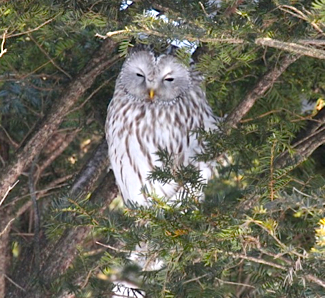
A wonderful bonus
while waiting for the cranes to dance- this Ural Owl flew
past the group, then perched nearby and settled down for a
nap. (Photo by guide Phil Gregory)
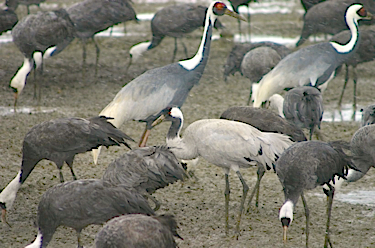
The crane fields
at Arasaki are a spectacular sight, with nearly 10,000
Hooded Cranes and 3000 White-naped Cranes amassed for the
winter! (Photo by guide Phil Gregory)
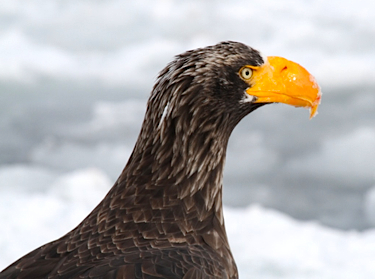
The magnificent
Steller's Sea-Eagle has the largest bill of any eagle;
along with that glaring yellow eye, it gives the bird a
pretty fearsome appearance. (Photo by guide Phil Gregory)
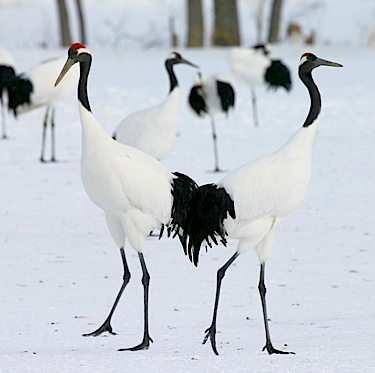
Red-crowned
Cranes, or tancho, as they are known in Japan, have a
well-deserved reputation for fidelity, making them a
popular symbol in Japanese wedding ceremonies. (Photo by
guide Phil Gregory)
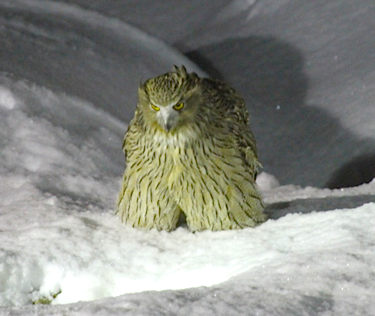
The Blakiston's
Fish-owl is revered as a divine being by the Ainu people
of Hokkaido; after the views we had on this tour, we're
pretty convinced they're divine beings too! (Photo by
guide Phil Gregory)
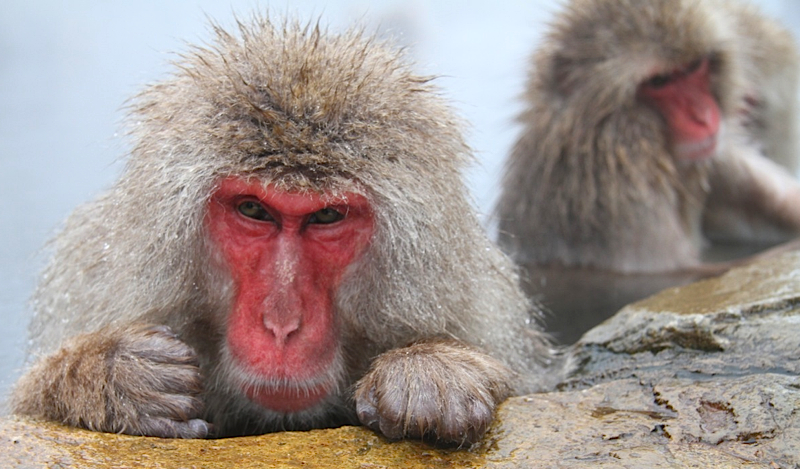
Onsen, or hot
springs, are widespread in Japan, and the use of them is
an integral part of the culture. So integral, in fact,
that even the monkeys partake in them! (Photo by guide
Phil Gregory)
MAMMALS
ADDITIONAL COMMENTS
It is hard to pick highlights from the tour as there were so many, certainly the Red-crowned Cranes in the snow is a big one, the Siberian Crane was a huge bonus bird, the Blakiston's Fish Owls were outstanding this year and the eagle trip off Rausu was terrific with unbelievably fine looks at Steller's Sea Eagle and White-tailed Eagle.
Wildfowl were quite a feature, with the pair of Scaly-sided Merganser a megatick, but Smew were great, Baikal Teal, Mandarin and Falacated Duck were lovely, and it is always nice to see the various sea ducks so well, with Harlequin and Long-tailed being tremendous. Bonus vagrant Ring-necked Duck and American Wigeon was nice, and we did well for swans with both Whooper and Bewick's as well as a vagrant Whistling, and Taiga Bean and White-fronted Goose showed very nicely too.
Solitary Snipe was a terrific find of a very tough species, and the smaller birds although few in number this winter showed well with Asian Rosy Finch and Long-tailed Rosefinch plus Japanese Grosbeaks being standouts.
The Snow Monkeys were also a major hit, well worth the trek through the deep snow to see this extraordinary sight, why they don't freeze to death once they get out is a puzzle to me!
Add to this the Japanese culture, and the intriguing hotels onsens and minshuku we stayed out and the many fine Japanese meals we sampled, washing-up must be a major industry in this country after the multi-course meals.
Totals for the tour: 149 bird taxa and 7 mammal taxa
